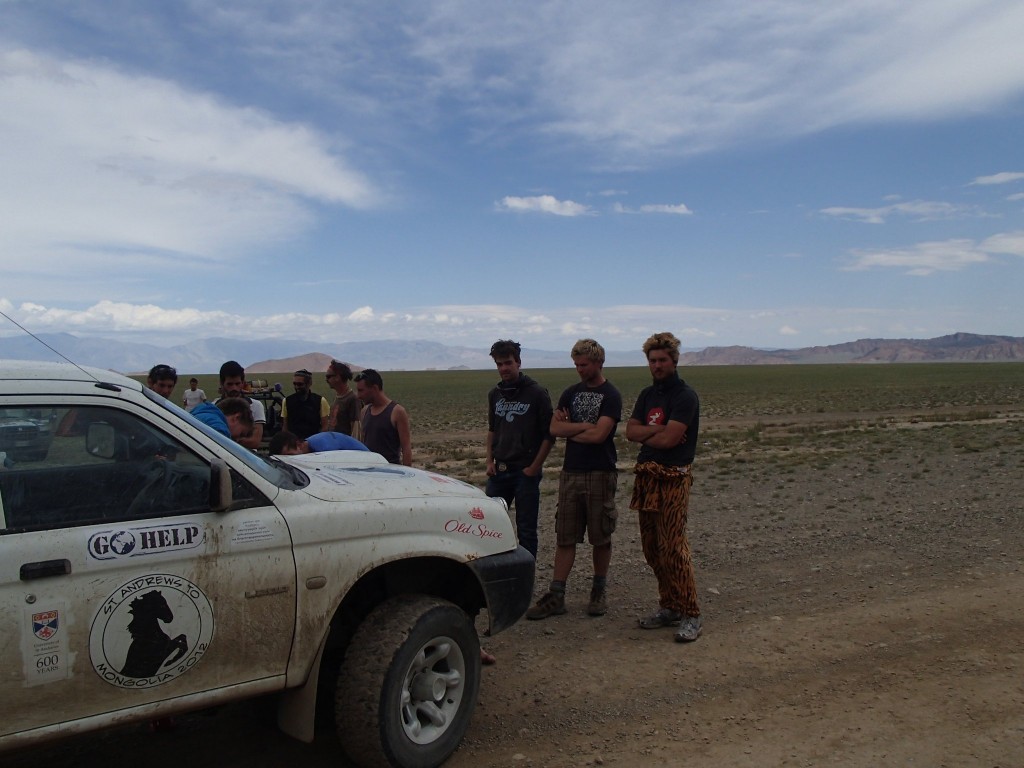 We woke up after a very wet night, put away the tents, re-organised the cramped ambulance with all our stuff and got on our way nice and early. The roads varied from tarmac, to gravel, to dirt, to sand, each with the possibility of being flat, very bumpy or having rivers cross them creating deep trenches. We were making good progress for the first few hours on the very bumpy road, until we stopped to change drivers and a wee-break. The rear suspension was completely down with air hissing out, giving us about 10cm of ground clearance. That definitely explained the very rough last part of the journey. We then stopped for roughly 3 hours trying to fix the problem. We reckon a stone got jammed in 1 of the 4 air suspensions and wore it away until it tore. All the air suspensions are connected, so with air escaping in one meant that all were flat. The designers of ambulances have obviously not heard of Mongolian ‘roads’.
We woke up after a very wet night, put away the tents, re-organised the cramped ambulance with all our stuff and got on our way nice and early. The roads varied from tarmac, to gravel, to dirt, to sand, each with the possibility of being flat, very bumpy or having rivers cross them creating deep trenches. We were making good progress for the first few hours on the very bumpy road, until we stopped to change drivers and a wee-break. The rear suspension was completely down with air hissing out, giving us about 10cm of ground clearance. That definitely explained the very rough last part of the journey. We then stopped for roughly 3 hours trying to fix the problem. We reckon a stone got jammed in 1 of the 4 air suspensions and wore it away until it tore. All the air suspensions are connected, so with air escaping in one meant that all were flat. The designers of ambulances have obviously not heard of Mongolian ‘roads’.
The first fix was using a sleeping Matt repair kit with various types of glue to fix the tear in the air suspension. This worked for a minute before we heard hissing again. Plan B involved disconnecting the broken air suspension to use just one on the left side using a piece of rubber tubing to connect the air tubes using zip ties. This also lasted a few minutes before it burst. Apparently zip ties were not strong enough for the air pressure. The next plan was using the T-junction from the broken suspension with a bolt blocking the extra hole to fill the surviving air suspension with air. This worked for a few minutes and we actually got the wheel back on, until the bolt violently shot out. Undeterred we went to Plan D and put the same bolt back in again, this time with MORE GLUE! This allowed for full suspension on the right side and half suspension on the left, more than enough for endeavor to limp onwards.
A few kilometers later a rather violent bump knocked the air compressor off from the middle of the ambulance, smashing off the air hoses, ruining all of the rear air suspension. With no available tools to fix the problem, we were forced to soldier on at roughly 20 km/h with about 10cm of clearance. This resulted in a slow bumpy ride, with every little bump in the track throwing people in the rear seats into the air. The hard journey was made easier by constantly watching torrential downpours either side of the ambulance as we tried to crawl away from the impending rain. If you can’t remember, by putting the spare tyres on the rood rendered the roof to leak water into the ambulance, making it no longer waterproof inside.
We played cat and mouse with the rain for the rest of the day until half 8 when we stopped for the day to camp. We had been driving away from a massive cloud of rain for the last hour and at our slow pace could not out drive it. Neil instantly bolted to the top of the ambulance as we stopped in order to start waterproofing the roof by using hot glue and a blow-torch, before the rain got over us. Amazingly the rain was not as bad as we thought and the glue worked well. The only issue was the intense wind that constantly threatened to blow away our cinch tents.
After quick tent pegging and food cooking, we sat down in the Gobi Desert to watch the amazing light display of distant lightning storms before going to bed.




Sorry to hear about Adventure, at least she reached Mongolia. Pleased to see you are endeavouring on towards Ulaanbaatar. Hope you stay dry. Best wishes Steve & Sue
Delighted to see you have made Ulaanbaatar, well done all of you. Looking forward to seeing you all at Heathrow next Thursday. Take care, Sheila and Dave Cooper